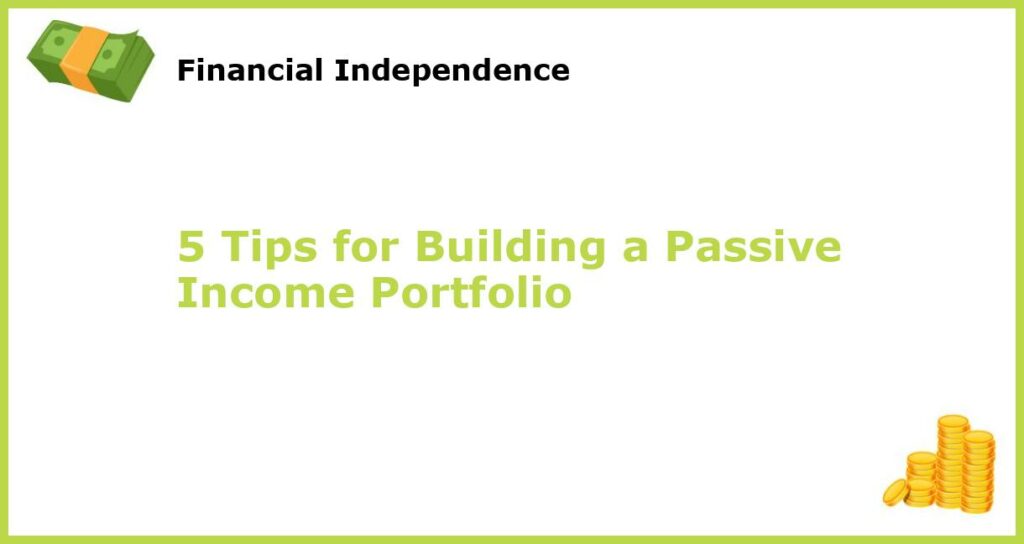Passive income is an excellent way to earn money while you sleep. It is money you generate without performing active work. Passive income streams can come from various sources such as rental properties or dividends from stocks. Nonetheless, investing in building a passive income portfolio can be challenging. It requires dedication, patience, discipline, and a long-term outlook. To build a successful passive income portfolio, you need to start with a solid foundation, diversify your assets, focus on dividend-paying stocks, be patient, minimize costs, think beyond stocks and bonds, reinvest your earnings, stay educated and informed, and seek professional help if needed.
Start with a Solid Foundation

Before you can start building your passive income portfolio, you need to have a solid foundation. This means paying off high-interest debt, establishing an emergency fund, and having a suitable investment account. The first step is to pay off high-interest debt, such as credit card debt, personal loans, or car loans. Debt repayment should be a priority because the interest rates can be higher than the potential returns of any passive income investments. Secondly, establish an emergency fund composed of three to six months of living expenses. It will provide a safety net to sustain you in the event of job loss or unforeseen expenses. Finally, you will need to open a suitable investment account. Depending on your goals, you may choose a Roth IRA, traditional IRA, 401(k), or a taxable brokerage account.
Diversify Your Assets

In investing, diversification refers to holding a variety of assets — stocks, bonds, and real estate, for instance — to reduce risk. Diversification ensures that your portfolio is not dependent on a single source of income. It is also important to diversify within asset classes. For example, with stocks, you can diversify by investing in different sectors like tech, healthcare, and consumer goods. You can also diversify by investing in real estate through real estate investment trusts (REITs). REITs invest in properties and distribute the rental income to shareholders. They also provide exposure to the real estate market without the hassle of managing individual properties.
Consider REITS

REITs are a great way to generate passive income from real estate. They are similar to mutual funds, but instead of owning stocks or bonds, you own pieces of real estate projects. They fund real estate projects then distribute rental income to shareholders. They can be purchased through a brokerage account and are required to distribute at least 90% of their taxable income to shareholders. You can also invest in a publicly traded REIT ETF or mutual fund, which holds a portfolio of individual REITs, providing diversification and lower fees.
Focus on Dividend-Paying Stocks

One of the simplest ways to generate passive income from stocks is through dividends. Dividends are payments made by companies to their shareholders and can give you a steady stream of income. It is essential to focus on companies with a history of paying dividends and a strong financial position. Dividend-paying stocks can be purchased through a brokerage account or through dividend-focused exchange-traded funds (ETFs). Dividend yield represents the annual dividend payment divided by the stock price, and it’s a good metric for measuring the potential return of dividend-paying stocks. High-yield dividend stocks can be tempting, but they’re often riskier because the high yield can be a sign of financial problems. Aim for a combination of high yield and solid fundamentals.
Be Patient and Think Long-Term

Patience and a long-term vision are crucial when building a passive income portfolio. It’s important to have a long-term plan and avoid getting caught up in short-term market fluctuations. Many successful investors espouse a buy-and-hold strategy, which involves selecting stocks or other assets and holding them for a long time. The key is to stick to your plan, diversify your assets, and remain disciplined. Consistency and patience are key to building a successful passive income portfolio.
Minimize Costs

High fees and expenses can eat into your investment returns, so minimizing costs is essential when building a passive income portfolio. This means choosing low-cost investment options like ETFs and index funds. These funds are passively managed, meaning they track an index or a specific market segment with minimal trading activity. They’re suitable for long-term investors who seek exposure to an entire market or market segment. It also means avoiding unnecessary trading and focusing on a buy-and-hold strategy. By keeping costs low, you can maximize your returns and build your wealth over time.
Think Beyond Stocks and Bonds

Passive income can be generated through a variety of assets beyond traditional stocks and bonds. For instance, peer-to-peer (P2P) lending platforms connect borrowers with investors willing to lend them money. P2P lending platforms earn fees for facilitating the transactions, which are then distributed to investors as interest. Rental properties like Airbnb or traditional long-term rentals can also provide passive income streams. You can also earn passive income from intellectual property like books and online courses. The key is to find income streams that align with your skills, interests, and risk tolerance.
Reinvest Your Earnings

Reinvesting your earnings is a powerful way to build a successful passive income portfolio. This means using the income generated from your assets to purchase additional assets. Over time, the power of compounding can significantly increase your passive income. By reinvesting your earnings, you can also diversify your portfolio and reduce risk. It enables you to achieve higher returns than withdrawing and consuming the capital. For example, dividend reinvestment plans (DRIPs) allow you to automatically reinvest dividends in the underlying stock, reducing transaction costs and fees.
Stay Educated and Informed

The investment landscape is constantly changing, so it is essential to stay educated and informed. This means keeping up with industry news, reading financial publications, and attending investment seminars. It also means being aware of your own biases and emotions when it comes to investing. A comparative study of different investment alternatives can help you make an informed decision. By staying informed and disciplined, you can make informed decisions and build a successful passive income portfolio.
Seek Professional Help
Building a passive income portfolio can be challenging, especially if you are starting out. Working with a financial advisor can be an excellent option to create a personalized investment plan, diversify your assets, and stay disciplined. They can also provide guidance and expertise when it comes to taxes, estate planning, and other financial matters. Financial advisors can help you identify your risk tolerance, financial goals, and develop a customized plan to meet them. They can also provide a fresh perspective to optimize your portfolio and streamline your investments.







